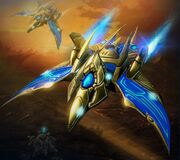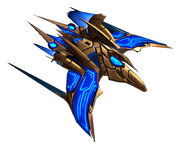No edit summary |
Tag: sourceedit |
||
| Line 38: | Line 38: | ||
===Propulsion=== |
===Propulsion=== |
||
[[File:Phoenix SC2 Game3.jpg|thumb|Phoenixes in flight]] |
[[File:Phoenix SC2 Game3.jpg|thumb|Phoenixes in flight]] |
||
| − | The Phoenix is propelled by a compact inertial drive, which surrounds the craft in a warp field, allowing swift displacement in deep space or planetary atmospheres.<ref name = "PhoeScience">2015-02-05, [http://us.battle.net/sc2/en/game/unit/phoenix#science Phoenix Science]. ''Blizzard Entertainment'', accessed on 2015-02-08</ref> Twin high-power plasma thrusters supplement the inertial |
+ | The Phoenix is propelled by a compact inertial drive, which surrounds the craft in a warp field, allowing swift displacement in deep space or planetary atmospheres.<ref name = "PhoeScience">2015-02-05, [http://us.battle.net/sc2/en/game/unit/phoenix#science Phoenix Science]. ''Blizzard Entertainment'', accessed on 2015-02-08</ref> Twin high-power plasma thrusters supplement the inertial drive, making the Phoenix a formidable interceptor craft. Additionally, an energy weave covers the Phoenix's wings, giving it an appearance akin to a circuit board. In reality, it is made out of light-reactive fibers that absorb, channel, and redirect all types of energy, including the pilot’s [[psionic]] input. The weave’s primary function is to maintain the coherence of the warp field that sheathes the Phoenix’s fuselage, and enhance the ship’s stability and maneuverability when banking, rolling, or sliding at high speeds.<ref name = "PhoeScience"/> |
===Armament=== |
===Armament=== |
||
Revision as of 12:24, 24 April 2015

|
You may be looking for:
|
|
The Phoenix is a protoss air to air unit in StarCraft II.
Overview
- A Phoenix pilot(src)
A deadly spacecraft[1] designed for aerial harassment,[2] the Phoenix is highly maneuverable,[3] possesses great speed,[2] and is able to outmaneuver almost any foe.[3] In use by 2502,[4][5] the Phoenix is rapidly replacing the older Scouts and Corsairs in the role of air superiority fighters for the protoss. Phoenix patrols are a common sight on the outer rim of protoss territory, where they sweep deep space for alien threats.[1]
Propulsion

Phoenixes in flight
The Phoenix is propelled by a compact inertial drive, which surrounds the craft in a warp field, allowing swift displacement in deep space or planetary atmospheres.[6] Twin high-power plasma thrusters supplement the inertial drive, making the Phoenix a formidable interceptor craft. Additionally, an energy weave covers the Phoenix's wings, giving it an appearance akin to a circuit board. In reality, it is made out of light-reactive fibers that absorb, channel, and redirect all types of energy, including the pilot’s psionic input. The weave’s primary function is to maintain the coherence of the warp field that sheathes the Phoenix’s fuselage, and enhance the ship’s stability and maneuverability when banking, rolling, or sliding at high speeds.[6]
Armament
The twin ion blaster armament of a Phoenix is highly suited for air-to-air combat,[1] and pack a punch against foes lacking armor.[2] Its main armament,[6] the blasters disintegrate their targets through short wavelength energy beams[2] composed of negatively-charged ions though can only be used against aerial targets.[2] These cannons are designed to allow the Phoenix to fire while on the move, but their short wavelength limits the travel distance of each shot, as well as the damage caused to heavily armored targets. The cannons' effective combat range presented a problem until the protoss began to replace the old focusing lenses with the more advanced anion pulse-crystals.[6]
When confronted by more dangerous enemies, a Phoenix pilot can unleash a short-lived gravity beam by overloading the ship’s warp field through its inertial drive.[3] The result is a beam composed of anti-gravity, which turns its target into a near-weightless object,[6] immobilizing it for a few precious seconds.[3] However, this is at the cost of the Phoenix's mobility. The beam was originally concieved as a weapon of last resort, but has since been embraced by the Great Fleet as an effective control weapon.[6]
Other Information
The following section contains information from a previous version of StarCraft II which is no longer valid.
|
Sophisticated and lethal as the Phoenix may be, all too often a patrol squadron will find itself heavily outnumbered by zerg or terran enemies. To overcome this weakness, phoenix pilots have developed a dangerous counter-ploy. A phoenix pilot can unleash a short-lived storm of destruction by overloading its warp field through the ship's ion blasters. The area-effect discharge is devastating and can destroy a large number of enemies at once, but it comes at a price: in the aftermath the phoenix is left temporarily powerless and crippled. Wary foes have learned to flee a phoenix overload and return moments later to destroy the helpless craft. In turn phoenix pilots have begun to use staggered discharges to catch their enemies in a web of destruction. These desperate tactics are frowned upon by protoss commanders, but have become tacitly accepted as a necessity.[1]
Game Unit
In-game, the phoenix lacks a ground attack, but makes up for this with its graviton beam. It is important to note that targets affected by the Graviton Beam can be hit by anti-air weapons, including other phoenixes. The phoenix can move and attack simultaneously which, combined with its high speed, makes it great for harassing fleeing forces. This also make the phoenix effective as an economy raider, using the graviton beam on worker units.

Early render of the Phoenix
The phoenix is very good at destroying light air units, such as mutalisks (especially with the range upgrade). The upgraded range of a Phoenix is double that of a mutalisk, allowing for players to easily fly around mutalisks, scoring free hits without the mutalisks being able to retaliate due to their slower speed.
The Phoenix is also an effective counter unit for vikings, banshees, and void rays. However, it is weak against strongly-armored units such as the battlecruiser, carrier, and corruptor. The phoenix is ineffective against the units it counters when outnumbered. However, it can makes up for this with its fast speed.
The phoenix banks when it turns.[7]
Abilities
Lifts target unit into the air, preventing it from moving, attacking, or using abilities. While using this ability the phoenix cannot move or attack. One in effect can be cancelled early to end the effects.
The effect ends instantly if either the targeted unit or the casting phoenix is destroyed.
Burrowed zerg units will be unburrowed by the ability, and will reburrow when they fall back to the ground.
| Usage | ||||
|---|---|---|---|---|
|
Upgrades
|
Increases protoss air unit armor.
|
|
|
Strategies

Unit profile
The Phoenix can lift anti-air units like the queen with the Graviton Beam ability rendering them vulnerable and helpless against void rays or other Phoenix.[8]
When grouped with void rays, the two ships complement each others' weaknesses and become a formidable fleet, with void rays firing at heavily-armored targets and ground targets while Phoenixes fire at poorly-armored targets.
Development
Quotations
Known Phoenix Pilots
- Admiral Urun
Notes
The Phoenix bears the same name as StarCraft alpha and StarCraft beta versions of the Wraith.[9]
References
|
